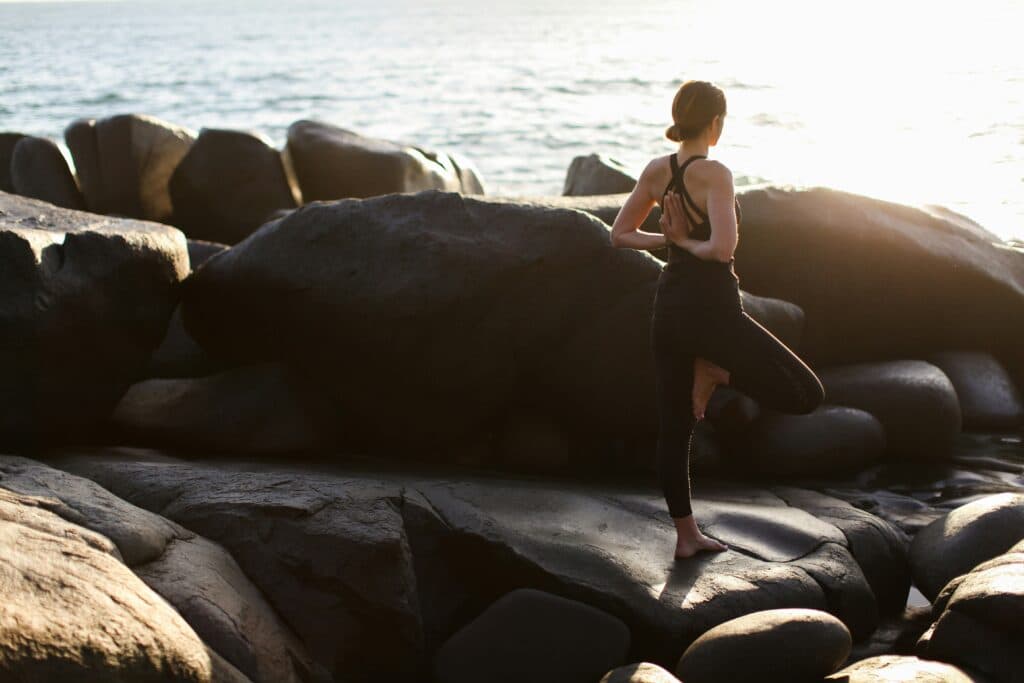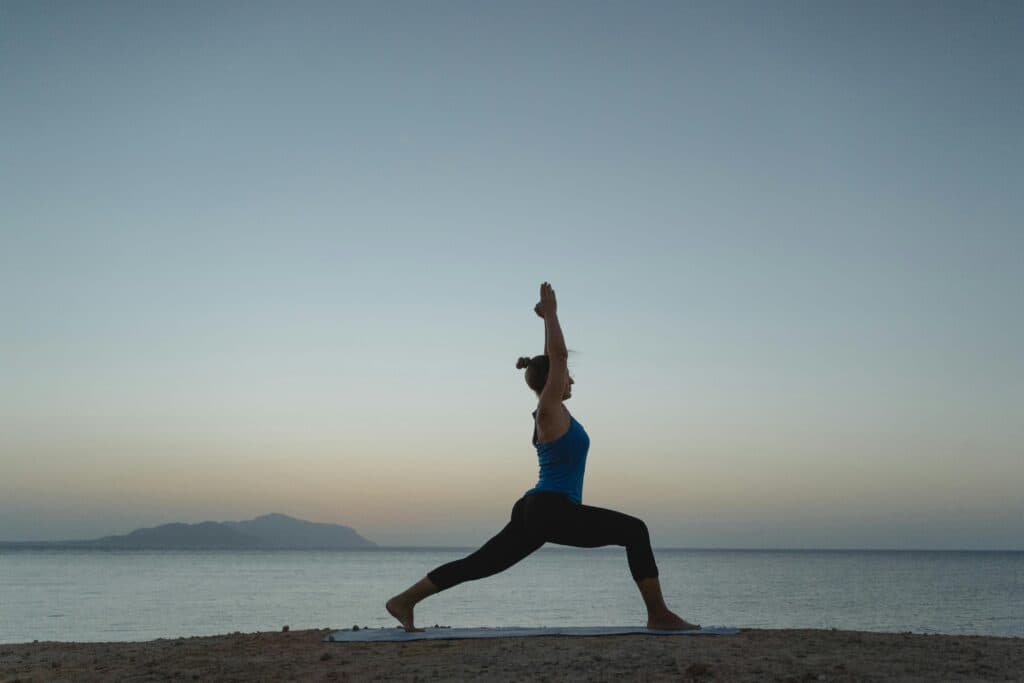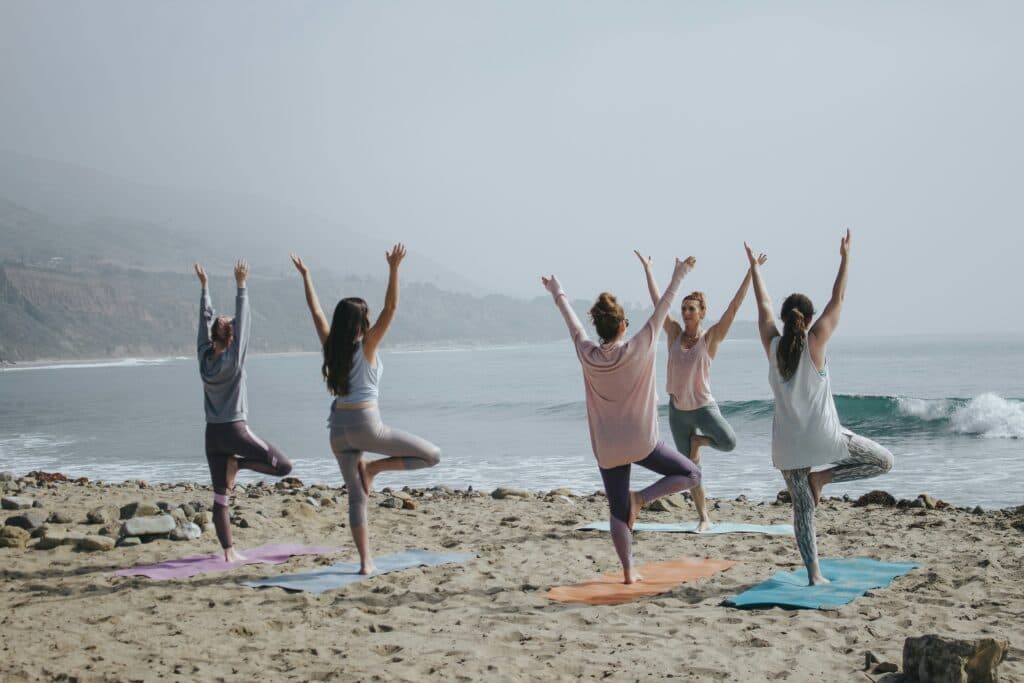Back to blog
Healthy Habits
Building Sustainable Habits in January: Why New Year’s Resolutions Fail (And What Actually Works)

Benefits of Yoga for Women
Popular Yoga Poses
Tips for Practicing Yoga as a Beginners
Yoga Exercises for Weight Loss
Yoga Movements that Increase Body Flexibility
The History of Yoga
FAQ
Popular Yoga Poses
Tips for Practicing Yoga as a Beginners
Yoga Exercises for Weight Loss
Yoga Movements that Increase Body Flexibility
The History of Yoga
FAQ
We always seek ways to nourish our minds, bodies, and sometimes our souls. Yoga has been known for thousands of years as one of the best ways to meditate and reach inner peace, and many people around the world practice Yoga as their favorite form of exercise. In this article, we will learn more about its history, types, and the names of the famous movements.
What Are the Benefits of Yoga ?

In our fast-paced world, where the pace of life can be overwhelming, finding calm moments and balance can feel like a distant dream. However, within the practice of yoga, there is a hidden treasure.
It offers a sanctuary from the chaos of life, a sanctuary from our daily pressures, and a path to finding peace and balance. It’s one of the best ways to slow down these racing thoughts, focus on the present, and cultivate gratitude. Here are some specific benefits of yoga:
Reducing Tension
Imagine yourself stepping onto your mat after a long and tiring day. You will feel the tension gradually disappear as you perform each pose as if you were completely still. You will shake off the day's worries with every breath and immerse yourself in the present moment. Yoga is a powerful antidote to stress and provides a haven to find calm amid the storm of thoughts and stress.
Enhancing Flexibility and Building Strength
Have you ever marveled at the grace and agility of yoga practitioners when they effortlessly flow through a series of poses? Yoga gradually builds flexibility and strength through consistent practice, allowing you to move with greater ease and fluidity in your daily life. Continuous practice can also resolve tightness in your muscles, giving you a feeling of freedom and liberation in your body.
Sharpening Mental Clarity and Reducing Negative Thinking
Life's whirlwind can often leave us feeling lost and disconnected. However, when you immerse yourself in the practice of conscious breathing and concentration in yoga, you'll embark on a journey of self-discovery. This is one of the most profound benefits of yoga, a path that many are drawn to. Yoga becomes a mental retreat, a space where you can organize your thoughts and tap into your inner reservoir of wisdom and intuition. Each moment of stillness brings a powerful awakening to your limitless potential.
Feeling Emotionally Balanced
Sometimes, we feel that life is a tapestry of emotions, some of which cannot be controlled, as if they are woven with threads of joy, sadness, love, and fear. Over time, you will learn to navigate this complex fabric with grace and flexibility through yoga. It develops emotional intelligence and enables you to embrace the full range of human emotions we often feel. When you deepen your connection to your breath and body, you discover an inner oasis of peace that does not waver amidst the storms of life.
Facilitating the Ability to Communicate with Yourself and Others
Yoga, at its core, is a journey of self-discovery and self-love. As you explore the depths of your being through breathing exercises and practicing various movements, you establish a deep connection with yourself that transcends the boundaries of ego and identity.
This journey is not just about personal growth, but about spiritual awakening and enlightenment. You will feel yourself awakening to the interconnectedness of all beings and the sacredness of life. Yoga becomes a bridge that unites you with the world, fostering a sense of humanity, empathy, and compassion for all living beings.
Increasing Self-confidence
Whether you're practicing yoga for beginners or advanced movements, you'll see that it's never about achieving perfect posture; It's about consciously connecting with your body and accepting all the flaws and feelings of physical weakness we feel when doing endurance exercises. Regular practice can develop body awareness and appreciation for its positives and negatives, leading to increased confidence, self-esteem, and self-worth.
What Are the Benefits of Yoga for Women in Particular?

Yoga offers a treasure trove of benefits that extend far beyond the physical realm. For women, in particular, yoga can provide unique support during different stages of life. Here's a closer look at how yoga can improve women's health, including its positive impact on mental health:
- Regulating hormones: special poses such as yoga asanas and breathing exercises (pranayama) can positively impact the hormonal fluctuations that women experience throughout their lives. Yoga can help regulate menstrual cycles, relieve premenstrual symptoms (PMS), and support fertility.
- Pain relief: yoga poses can target specific areas to relieve pain that women commonly experience. Gentle stretching and mindful movements can help manage back pain, relieve menstrual cramps, improve overall flexibility, and reduce discomfort.
- Pregnancy support: there is yoga specifically for pregnant women under the name (prenatal yoga). It is considered a safe and effective way to keep women active and increase their sense of vitality during pregnancy. Yoga promotes strength, flexibility, and good posture, which may ease pregnancy pain and prepare a woman's body for childbirth.
- Postpartum recovery: yoga can be a gentle and effective way to regain strength and flexibility after giving birth. It can also aid in postpartum recovery by promoting relaxation, reducing stress, and improving sleep, which is essential for new mothers.
- Building a supportive community: many yoga studios provide welcoming and inclusive environments. Joining a women's yoga class can give a sense of community and connection with like-minded women, promoting support and friendship.
Popular Yoga Poses
Yoga includes many movements that fall under the movements of meditation and flexibility. Yoga moves and poses can be found for beginners all the way to the advanced level. Here are some of the most common movements:
Mountain Pose (Tadasana)

This movement depends on standing and bringing the feet together, pressing on the four corners of the feet and raising the chest to remain straight. The arms are then extended above the head with the palms of the hands facing each other. This pose improves posture, strengthens the legs, and develops a sense of stability.
Downward Facing Dog (Adho Mukha Svanasana)

This movement is called a downward-facing dog because it relies on placing the palms of the hands on the floor and placing the feet back. The hip must be raised toward the ceiling so that the body forms an upside-down V shape. The palms and heels should be pressed into the floor while lengthening the spine. Downward Dog stretches the hamstrings, calves, and shoulders while also energizing the body and calming the mind.
Warrior I Pose (Virabhadrasana)

The first step on warrior I is taking the foot back and bend your front knee to create a 90-degree angle, while keeping the back leg straight and strong. Then extending the upward so that the palms of the hands face each other while looking forward. The Warrior I movement builds strength and stability in the legs and also opens the chest and shoulders, increasing the feeling of flexibility and freedom, while getting the feeling of confidence and empowerment.
Chair Pose (Utkatasana)
Chair pose strengthens the quadriceps, hamstrings, and core muscles, and improves balance. You should stand with your feet hip-width apart, sit in a cross-legged position as if you were sitting on a chair, and extend your arms up.
Tree Pose (Vrksasana)

The tree pose is about standing tall on one leg, while placing the sole of the other foot on the inner thigh or the beginning of the leg, and avoiding placing it on the knee because it may cause pain in the future. Press your foot into your leg and gaze at a specific point in the room to achieve balance. The hands are placed on the middle of the chest or extended above the head like branches. Tree Pose improves balance, focus, and hip mobility while also promoting a sense of inner peace.
Child's Pose (Balasana)

Kneel on the floor in child's pose, then sit on your heels and lean forward, placing your forehead on the mat and extending your arms in front of you or beside your body. Child's Pose stretches the hips and thighs and relieves pressure in the lower back while relaxing the nervous system.
Corpse Pose (Savasana)
In corpse pose, lie on your back with your arms and legs extended, palms facing up. Close your eyes and allow your body to completely relax on the floor. Corpse Pose is a final relaxation pose that promotes deep rest and rejuvenation, allowing the benefits of your practice to fully integrate into your body and mind.
Tips for Practicing Yoga as a Beginners
The benefits of yoga extend to beginners and advanced alike, regardless of age, fitness level or experience. If you're new to yoga and curious to explore this practice, here are some tips to get started:
- Start slow: don't feel pressured to jump into advanced poses right away. Focus on mastering the basics and gradually building your practice over time.
- Listen to your body: pay attention to how your body feels in each position and respect any restrictions or discomfort. Modify positions as needed and never push yourself into pain.
- Remember to breathe well: breathing is the foundation of yoga. Focus on deep, steady breathing throughout your practice to help calm the mind and connect with your body.
- Use yoga props: feel free to use props such as blocks, straps, or blankets to support your practice and make poses easier.
- Find a beginner's class and don't rush to start with advanced movements: consider taking a beginner-friendly yoga class or following online yoga for beginners tutorials. A qualified instructor can provide guidance and support as you begin your yoga journey.
Yoga Exercises for Weight Loss

Although yoga is not solely focused on weight loss, it can certainly be a valuable tool in your weight management journey. It can be an effective weight loss tool when combined with a healthy diet and regular exercise. While yoga may not burn as many calories as high-intensity cardio, it does offer a variety of benefits that can support weight loss and overall health. Here are some ways yoga can contribute to weight loss:
- Vinyasa Yoga: this dynamic style links movements with breathing, creating a continuous flow that keeps the heart rate regular.
- Ashtanga yoga: this powerful practice follows a specific series of poses, turning up the heat and burning calories.
- Power yoga: a more intense version of hatha yoga, power yoga focuses on building strength and endurance, which results in higher calorie burn.
Yoga Movements that Increase Body Flexibility
Yoga is known for its ability to enhance flexibility, mobility, and range of motion throughout the body. By practicing a variety of yoga poses that target different muscle groups and joints, you can gradually increase your flexibility and experience greater ease and freedom of movement. Here are some yoga poses specifically designed to improve flexibility:
Cobra Pose (Bhujangasana)

Lie on your stomach with your hands on the mat next to your ribs in a cobra pose. Inhale and exhale as you press your palms into your hands and lift your chest off the mat, keeping your elbows close to your body. Lengthen your head and pull your shoulder blades down your back. Cobra pose tightens the front of the body, including the chest, abdomen and hip muscles.
Pigeon Pose (Eka Pada Rajakapotasana)
Start in a tabletop position and bring your right knee toward your right wrist to try pigeon pose, then move your right foot toward your left wrist. Extend your left leg behind you and lower your hips toward the floor. You can stay upright or fold forward on your front leg to deepen the stretch in your hips and buttocks. Repeat on the other side.
Sitting Forward Bend (Paschimottanasana)

The forward bending position is based on sitting on the floor with the leg extended forward. Inhale as you lengthen your spine, then exhale as you move forward from your hips until you reach your feet. Keep your back flat and chest open, while avoiding rounding your spine. Maintain this position for several breaths, feeling the stretch in your hamstrings and lower back.
Cow Face Pose (Gomukhasana)
To do a cow pose, sit on the floor with your legs extended in front of you. Bend your knees and place your right knee over your left knee, so that your feet are toward your hips. Extend your right arm above your head and bend your elbow, then place your left arm behind your back and bend your elbow. Clasp your hands together behind your back, or use a belt to close the gap between your hands if necessary. Repeat on the other side.
Triangle Pose (Utthita Trikonasana)

In triangle pose, start in a wide-legged position with your feet parallel to each other. Turn your right foot to the side and extend your arms parallel to the floor. Extend your right hand toward your right foot, placing it on your leg, ankle, or the floor, and extend your left arm toward the ceiling. Keep your legs straight, your torso long, and look at the top of your hand. Repeat on the other side.
Butterfly Pose (Baddha Konasana)
For butterfly pose, sit on the floor with the soles of your feet together and your knees bent out to the sides. Grasp your ankles or feet with your hands and sit tall. Press your knees toward the floor to deepen the stretch in your thighs and inner thighs. You can gently move your knees up and down to release tension in your hips.
What is the History of Yoga ?
Do you ever wonder, how old is yoga and when did it start? The history of yoga goes back more than 5,000 years, to the Saraswati civilization in northern India. This is why we find that the names of yoga movements go back to the ancient Sanskrit language like we mentioned earlier.
Initially, yoga was developed as a spiritual practice aimed at achieving enlightenment and self-awareness. The first recorded mention of yoga throughout history was in the Rigveda, one of the sacred Indian texts dating back to about 1500 BC. Yoga has developed over the ages and diversified to include stretching and relaxation movements, and is no longer just about sitting and meditating.
FAQ
Is yoga for everyone?
Yoga positions are adaptable to most bodies and fitness levels. However, it is always best to consult your doctor before starting any new exercise program, especially if you have any pre-existing health conditions or injury.
What equipment do I need to practice yoga?
A yoga mat is all you really need. As you progress, you can explore props such as yoga blocks, straps, and bolsters to enhance your practice.
How often should I practice yoga?
Aim for at least 2-3 sessions per week for optimal results. It will be helpful to know yoga poses names in order to practice the best movements for your level.
Whether you are reading this article to learn about why yoga is important for beginners or advanced practitioners, you must have noticed the many benefits of yoga for all levels. If you want to read more about health, you might find Top Health Tips for a Balanced Lifestyle and How to Eat Healthy Food on a Budget very helpful. You can also find more interesting topics in our Calo blog.








